Super Robot Wars J Review
Posted by CmdrKing on March 5, 2011Platform: Gameboy Advance
Publisher: Banpresto
Developer: Banpresto
Release Date: September 2005
Patch: Romhacking Aerie
Patch Release: December 2010
Super Robot Wars (or Super Robot Taisen, whichever floats your boat. We’ll be calling it SRW for the rest of this review) enjoys a comfortable margin of obscurity in the English speaking world. If you spend some time among the sufficiently geeky, or just like giant robots and use Youtube, you’ve probably run across some reference to the series. However, due to the myriad issues of licensing in anime, video games, and massive crossover plots, the series would be too costly a venture to try and bring across the pacific, at least considering the need to build up a sufficiently large fanbase. While Atlus did, quite surprisingly, roll the dice on the first two Original Generation games, as well as its spin-off Endless Frontier, a shoestring budget will just never be enough to publish a traditional game, with all the bells, whistles, and rocket punches of a dozen different series welded into a single narrative. Fortunately, a fanbase as geeky and dedicated as SRW’s has all the ingredients needed to put together a fan translation, and thus we have Super Robot Wars J, the final release from the GBA, to enjoy today.
Before getting to the bullet points that make up a review, it’s important to realize that SRWJ is a traditional SRW, by which I mean a crossover SRPG involving giant robot anime. In any crossover, one of the most important bits is cast list, so I’ll be getting that out of the way before getting into the rest. Aside from the Originals, which we’ll cover when discussing the plot proper, SRWJ features the epynonymous Nadesico and Gundam SEED’s Archangel as its battleships, with the casts of Combattler V, Mazinkaiser, Voltes V, Dancougar, G Gundam, Full Metal Panic!, Tekkaman Blade, Brain Powered, SPT Layzner, and Zeorymer rounding out the cast. If you haven’t heard of those last four, that’s okay, Tekkaman Blade was called ‘Teknoman’ in its US release and the last two have never left Japan. While Combattler V and Dancougar are fairly tangential to the plot, the rest provide at least part of the villain cast at various times, with Tekkaman Blade, Layzner, Gundam SEED, and Nadesico villains forming the core antagonists throughout the game.
In a way, Super Robot Wars has three phases to the game, each utilizing a different graphical style. The story told between missions typically features one of a small handful of backgrounds as a backdrop while text boxes marked with the portrait of talking characters do the actual story telling. There’s little to note about these; these portraits have to replicate existing art styles for known characters, and do a credible job of it. The second phrase, the strategic element, is a simple background marking terrain, the movement grid, and small icons marking each unit, in the shape of that unit’s head. This works, although not always perfectly since plenty of units look quite similar (hello X Numbers). Fortunately, truly identical units (such as the Aestevalis piloted by the crew of Nadesico) have letters as distinguishing marks. The last phase is less a phase and more of a show, and that’s the animation sequences once an attack is initiated. You can find demo videos for any popular character all over Youtube, and it’s not hard to see why; Banpresto puts a lot of work into those animations. So it’s to be expected that SRW J makes the GBA do things that seem out of character. It’s really a matter of just using a lot of frames animating the sprites, but when you consider the game has upwards of 50 characters, plus no shortage of different enemy units, it’s really an intimidating amount of work, and the overall effect is pretty awesome.
There’s less good things to say about the sound. The sound effects are pretty stock. SRW has never put much effort into background music, and that trend continues here. The GBA was functionally useless in terms of internal sound equipment, so nobody thought to give the thing useful sound cards either. What this means for J is that its efforts to replicate the sound of music originally written for anime fell flat a considerable majority of the time. There’s a few successes mixed in (Dancougar’s Heat of Anger for example) but they’re in the minority. The other exception is the original music. Since those themes were actually composed for the GBA’s special needs, they work even without a nostalgic affection for chip-tunes. In particular I enjoyed the heroine’s theme, Revenge (sometimes known as Revenger) and typically turned her attack animations on simply to make it replace the sleep-inducing background music.
Basically the best music you can get out of the GBA.
As we begin the game, Earth and its colonies teeter on the brink of full scale war between the Earth Federation and the PLANTs (that’d be Gundam SEED’s plot). However, our story instead follows the crew of the Nadesico, sent to investigate the sudden loss of the Mars colonies. There, they discover that the mysterious unmanned drones known as the Jovian Lizards (Nadesico, naturally) seem to be working in tandem with the forces of the Gradosian Empire (Layzner). A series of misadventures trying to evade this force leads them back to Earth months later, by which poin war between the surface and colonies has gone into full swing, and the Nadesico’s fate becomes entangled with that the Federation ship Archangel (SEED again). Underscoring all of this is the continual invasion of alien plant-life slowly overtaking Earth’s natural flora, along with continual attacks by insectoid monsters known as the Radam (Tekkaman Blade). Faced with overwhelming odds, the two crews must go from hot spot to hot spot to try and keep the Earth in one piece.
Inter-weaved with all that madness is our main characters. At the start of the game, you select between a young boy named Touma and a woman named Calvina, and while they fulfill many of the same story roles in relation to the unique villains of the game, each is a distinct personality with a completely different story line; Touma falls into the cockpit and ends up on the Nadesico by chance, while Calvina is hired as an advisor owing to her experience as a retired Ace Pilot and survivor of an attack on the training facilities on Mars. While the development of your chosen protagonist is a big part of the story line, they and the new villains interact with the stories of various series hardly at all, rarely altering the way storylines play out. The original villains, the Fury, do occasionally step out to demonstrate their power and beat down other villains, but there’s no real team up or interference with their plans until the endgame once your crew has already done most of the damage.
Yeah, this sort of thing is what gets people into SRW.
On the whole, it all works pretty well, with one glaring issue. There is way, WAY too much Gundam SEED plot in this game. To be sure, if you’re going to give a game one of the main battleships of a series, you expect a lot of its plot. Indeed, the game has four or five portions in which the two ships split up for a while, and most of those maps deal with the plot of their respectifve shows. And yet, even taking the Nadesico at every path split, as much of the game is dedicated to Gundam SEED’s storyline as Nadesico’s, effectively meaning that its plot drowns out the rest of the game at times. The trouble with this is that Gundam SEED’s plot doesn’t make a lick of sense in this context. Both sides in the Earth/PLANT war should be devastated by the Radam, SPT, and Jovian forces you fight routinely. Trying to present forces like the X Numbers as credible threats to your army gets old very fast. But most of all, Gundam SEED is very much a plot about intolerance and racism. Both sides in the conflict want to fight the other to the exclusion of all other threats, and to the point of utter genocide. The villains go on about wiping out the inferior genetic scum/mutant impurities. Except, y’know, the Earth is under full scale assault by no fewer than 4 alien races, nevermind threats like Orphan. The only thing I can really say positive about Gundam SEED, based on this game, is that it reflects more poorly on that show than SRWJ.
The core gameplay is a fairly straightforward turn-based strategy. Turns are divided into Player and Enemy (and occasionally Neutral, although this is typically used to have two separate, hostile-to-each-other enemy forces on the map, but once or twice they are allied units you can’t control) Phases, during which you perform any actions you want for the turn. Each map is layed out in a grid and has different elements of terrain. Like many SRWs there are four basic types (Air, Ground, Water, and Space) along with obstacles like woodland, mountains (which hinder movement but enhance defense), and helpful elements like bases (which provide regeneration and the like). Each unit has individual strengths and performs better on some terrains than others, although you can use parts and upgrades to alter these. Each unit has a unique selection of attacks, which are effective at different ranges and are of differing power. In addition to range and power, each attack has different properties which determine how and where they can be used; the P symbol marks moves that can be used after moving, C attacks can strike multiple enemies as long as they’re in a line and the attack is initiated at minimum range, and while each MAP attack has different range and area of effect properties, all have the effect of ignoring the standard battle screen and thus denying enemies the chance to counter attack, defend, or support each other. Support, while present in many SRW games, is of particular note in J because many, many units both player and enemy use it. Essentially, if two units are adjacent, they can support each other. Support Defense kicks in when the unit is attacked, and allows the supporting unit to take the attack at halved damage, while Support Attack essentially lets the two units tag team the enemy, but without using up the supporting unit’s turn.
SRWJ also uses RPG elements, which affect the pilots of various units. As they attack enemies and level up, not only do they gain stats (the way pilot and mech stats interact are complex, and don’t really matter much because very few pilots can use multiple machines) but they learn new support skills, such as additional uses of Support Attack/Defense, gain bonus points that can be distributed freely to their stats, and they learn new Spirits. Spirits are commands that are used on the player turn, and while they consume the pilot’s SP they don’t take a turn to use. A big chunk of the worth of a given unit is its pilot’s Spirit list, because Spirits have incredibly useful effects like automatically evading the next attack, doubling the damage on your next attack, having perfect accuracy for the next turn, and so on.
Beyond simple levelling, which takes quite a while to get rolling, you power up your units via upgrades and parts. Parts are simple enough, effectively just equipment which provides effects like raising effectiveness on a given terrain, boosting stats by a fixed amount, and similar things. There are also equivalent items, called Modules, which are equipped to pilots and raise things like SP and other core stats, in addition to enabling skills like Support Attack. However, the most important aspect is upgrades, which require money and permanently raise the stats of a mech or its weapons. Each mech has a unique limit on how many times each stat (HP, EN, Mobility, Armor, with weapons all sharing the same upgrade bar as well) can be upgraded, and upgrades cost progressively more per point invested. However, once you fully upgrade a mech’s stats or weapons, you can assign it a bonus. These bonuses, in particular giving S ranks on all terrain, are quite potent and for the most part a fully upgraded, bonus’d unit can destroy dozens of endgame enemies by themselves.
Granted, a large part of that is SRWJ being a fairly easy game with relatively weak enemy units. However, while the game is pretty easy it never quite reaches the point where it feels like you don’t have to try. Sure, any well equipped unit can sweep through maps, but neither is it wise to send an un-upgraded unit head first into enemy forces without support. Essentially, the game is easy enough to use any unit you want and still be effective, but not so easy that it doesn’t reward playing well and knowing what you’re doing.
Which is good, since SRWJ has some built-in incentive to play the game repeatedly. Like most modern SRW games, J uses the Favorites system, in which at the start of the game you pick three of the participating series. All mechs from those series gain bonuses to how much experience and money they get for shooting down enemies. This has the practical effect of discouraging you from using any other units. However, as you replay the game you simply add to the list of casts with the Favorites bonus, encouraging you to mix things up on each play through. And in addition to having a completely different main character to choose from, there are actually three mechs associated with the main character, of which you get to use one each playthrough. Use them all, and get a fourth bonus mech to play with the next time around! And of course there’s the alternate path splits, although why you’d want to see more Gundam SEED plot is beyond me.
Owing to being a mission driven strategy game, you wouldn’t expect too much in the way of secrets from the game, but SRW has always prided itself on teasing players with how hard to get some of the hidden mechs can be. At least one of J’s secrets is pretty much pure FAQ bait, even now that we can actually read the text and understand the hints in the dialogue. There’s also the Puzzle Robo section. Accessible in the intermission menu (where you can do your upgrades and such), Puzzle Robo is… well, basically it’s gimmicky missions set in the main battle system. Some are simply incredibly hard (killing every enemy within your first player phase, for example), but many others are unusual examples like trying to reduce your unit’s EN to minimum or the like. Each map hands out about as much money as doing a full story map, as well as a relatively rare part, so it’s worth doing them all (or, if you’re lazy like me, FAQing them all.)
All in all, SRWJ is just an enjoyable game. It’s easy in an inoffensive way, the story flows pretty well considering the jumble that is crossover plots, the main character story arcs are a lot of fun, and despite being a GBA game its still flashy and a lot of fun to watch in action. It’s probably the best SRW game you can play without knowing a lick of Japanese, and you should really check it out if you’ve got any affection for strategy games or giant robots.
Pros: Good cast chemistry, enjoyable if easy map design
Cons: GBA synth + anime themes = not so much
WTF?: So, so, SO much SEED plot.
Final Grade: 8/10
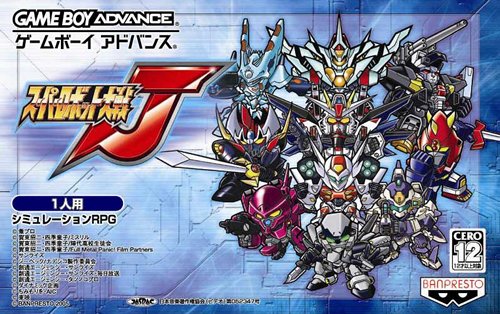
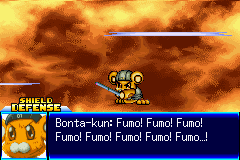
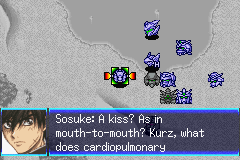
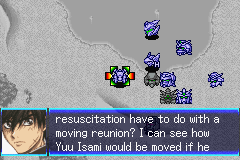
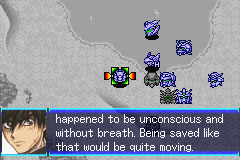
Add A Comment